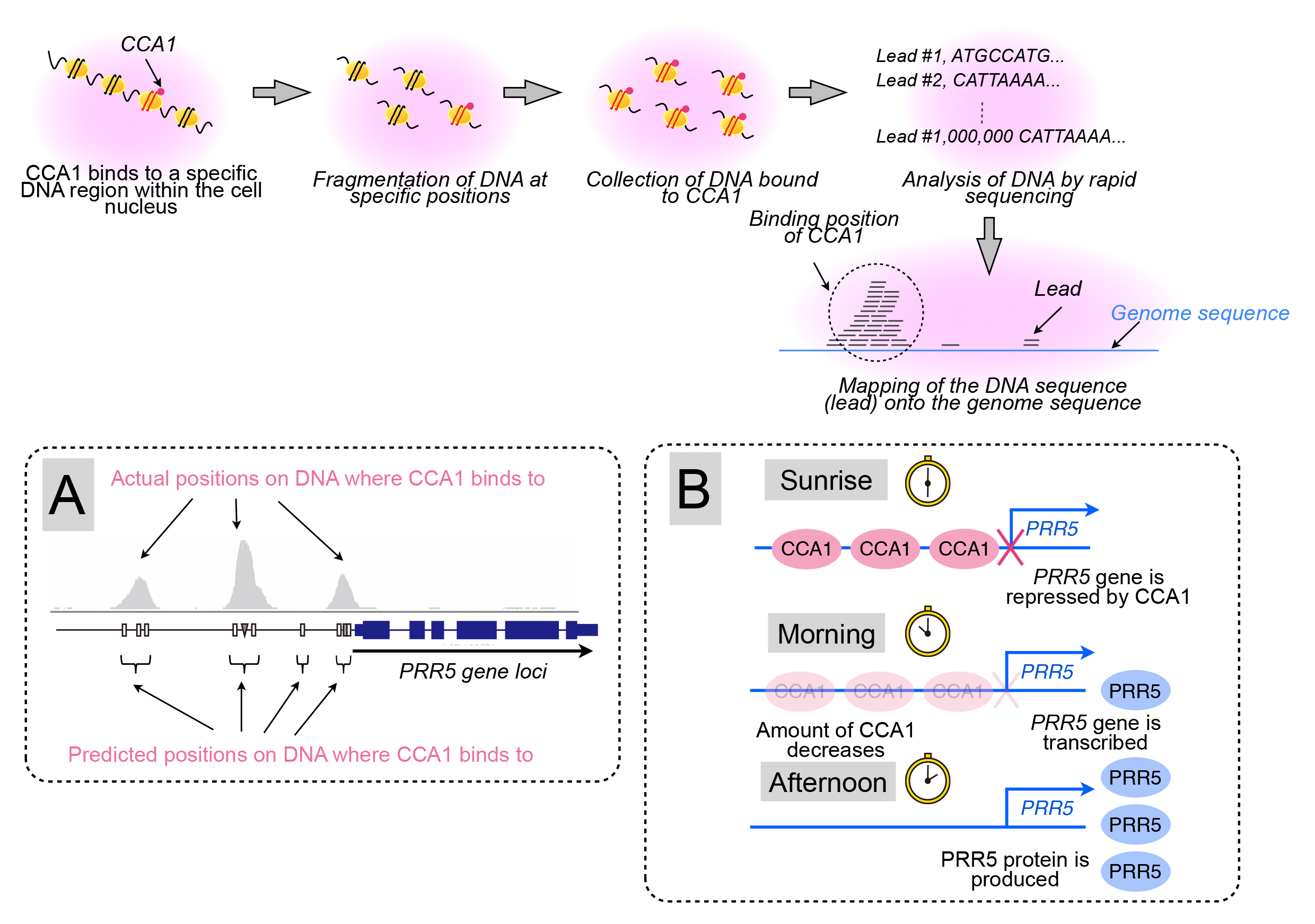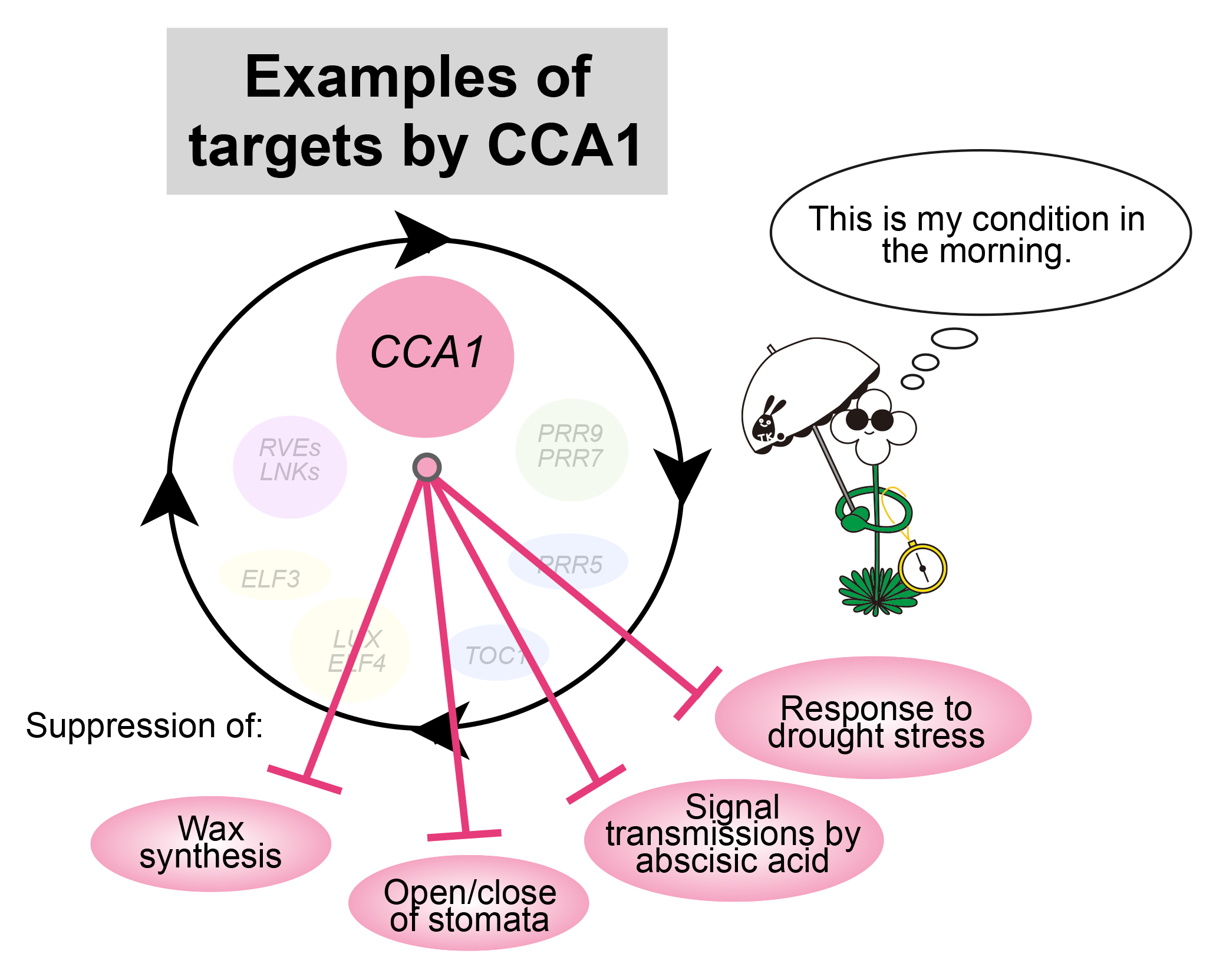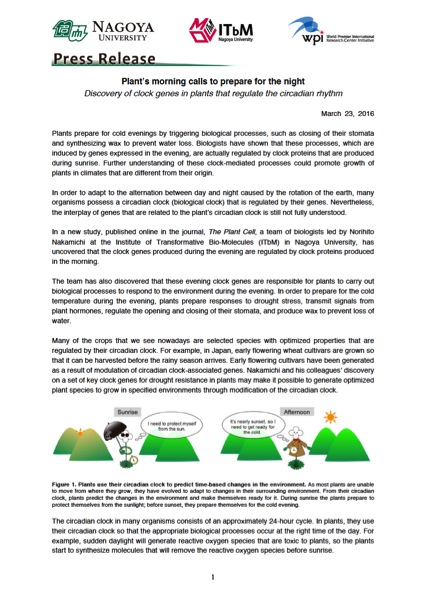Research Highlights
Plant's morning calls to prepare for the night ~Discovery of clock genes in plants that regulate the circadian rhythm~
Plants prepare for cold evenings by triggering biological processes, such as closing of their stomata and synthesizing wax to prevent water loss. Biologists have shown that these processes, which are induced by genes expressed in the evening, are actually regulated by clock proteins that are produced during sunrise. Further understanding of these clock-mediated processes could promote growth of plants in climates that are different from their origin.
In order to adapt to the alternation between day and night caused by the rotation of the earth, many organisms possess a circadian clock (biological clock) that is regulated by their genes. Nevertheless, the interplay of genes that are related to the plant's circadian clock is still not fully understood.
In a new study, published online in the journal, The Plant Cell, a team of biologists led by Norihito Nakamichi at the Institute of Transformative Bio-Molecules (ITbM) in Nagoya University, has uncovered that the clock genes produced during the evening are regulated by clock proteins produced in the morning.
The team has also discovered that these evening clock genes are responsible for plants to carry out biological processes to respond to the environment during the evening. In order to prepare for the cold temperature during the evening, plants prepare responses to drought stress, transmit signals from plant hormones, regulate the opening and closing of their stomata, and produce wax to prevent loss of water.
Many of the crops that we see nowadays are selected species with optimized properties that are regulated by their circadian clock. For example, in Japan, early flowering wheat cultivars are grown so that it can be harvested before the rainy season arrives. Early flowering cultivars have been generated as a result of modulation of circadian clock-associated genes. Nakamichi and his colleagues' discovery on a set of key clock genes for drought resistance in plants may make it possible to generate optimized plant species to grow in specified environments through modification of the circadian clock.

Figure 1. Plants use their circadian clock to predict time-based changes in the environment. As most plants are unable to move from where they grow, they have evolved to adapt to changes in their surrounding environment. From their circadian clock, plants predict the changes in the environment and make themselves ready for it. During sunrise the plants prepare to protect themselves from the sunlight; before sunset, they prepare themselves for the cold evening.
About the research:
The circadian clock in many organisms consists of an approximately 24-hour cycle. In plants, they use their circadian clock so that the appropriate biological processes occur at the right time of the day. For example, sudden daylight will generate reactive oxygen species that are toxic to plants, so the plants start to synthesize molecules that will remove the reactive oxygen species before sunrise.
During the afternoon, plants make themselves ready to deal with the cold temperatures that will follow sunset. In this manner, plants use their biological clock to respond in beforehand to the changes in their surrounding environment that are caused by variation in time.
The circadian clock is considered to consist of mutual regulation between multiple genes, but this complicated network of genes and molecules has not been fully clarified. Norihito Nakamichi, an associate professor at ITbM and a leader of this study who has been carrying out plant circadian clock since 2004, decided to look into how various biological events are regulated by the clock. "The reason why I am interested in studying the biological clock is because I really like the logic behind how various biological processes are brought about by the plant's complex clock network," speaks Nakamichi.

Figure 2. Various biological processes are controlled by the plant's circadian clock. The circadian clock is regulated by an approximately 24-hour cycle. This clock mechanism determines the time of occurrence for various biological processes. Events that are regulated by the clock are called clock outputs.
"Since 2011, we have been trying to find the key factor that regulates the expression of the gene that is transcribed during the afternoon," says Nakamichi. The group used PSEUDO-RESPONSE REGULATOR 5 (PRR5), which is a clock gene of the model plant, Arabidopsis thaliana.
"We first hypothesized that CCA1, which is a clock protein that is generated during sunrise, binds to a specific DNA sequence that is involved in the expression of the target gene PRR5," describes Nakamichi. "We collected the CCA1 protein bound to DNA by a technique called Chromatin immunoprecipitation (ChIP), and analyzed the DNA sequence by rapid DNA sequencing." Although rapid DNA sequencing is a well-known technique, comprehensive analysis of the DNA sequences can be a rather complicated process.
"We actually had to go back and forth many times until we were able to identify that the PRR5 gene appears at the regulatory region at a high frequency," continues Nakamichi. "I was extremely excited when I saw the data suggesting that the CCA1 protein directly acts towards the regulatory region of the PRR5 gene and has a major effect on it."

Figure 3. CCA1 clock protein binds near the PRR5 gene within the cell. 1) The CCA1 protein and chromosomal DNA are bound together within the plant cell; 2) Fragmentation of chromosomal DNA; 3) The CCA1 protein is collected and the DNA bound to is analyzed by rapid DNA sequencing; 4) The lead (DNA sequence) is mapped to the genome sequence to reveal the genome region that CCA1 binds to. (A) shows the actual and predicted positions that CCA1 binds to on the DNA sequence. CCA1 binds to three positions near the PRR5 gene. (B) The CCA1 protein represses the PRR5 gene during sunrise. As time proceeds, the amount of CCA1 decreases and the PRR5 gene is transcribed, leading to an increase in the PRR5 protein, which is responsible for various biological activities for the plant during the evening.
In addition, the group found in the plant cell's chromosome, the target DNA region of the CCA1 clock protein. "We found many genes that are expressed in the evening nearby the DNA region that CCA1 binds to," explains Nakamichi. Some of these genes are responsible for the plant's responses to drought stress, transmission of the signals from the plant hormone, abscisic acid, regulation of the opening and closing of stomata, and production of wax. "The results of our studies suggests that the CCA1 protein induces these biological processes to occur at a specific time during the evening."

Figure 4. Elucidating the target gene of the CCA1 protein. The CCA1 protein directly represses the key gene expressions for the plant's responses to drought stress, signal transmission by abscisic acid, opening/closing of stomata, and production of wax. As CCA1 is mainly present in the morning, these events are suppressed in the morning, when there is no need for the plant to prevent itself from losing water.
"Plants have a sophisticated clock system where the appropriate biological processes occur at the correct time of the day. If the CCA1 protein did not function in the morning, the plant will start preparing for the cold and prevent water loss during the day," says Nakamichi. "By being able to switch on and off the function of the clock proteins at the correct time, this may facilitate growth of plants that are adaptable in different climates," he continues.
"The genes related to the circadian clock are common in many plants. Many of the crops that have been selected so far are actually ones that had sudden changes, either naturally or artificially, in the genes that control their circadian clock," says Nakamichi. "We believe that our work has contributed to further understanding of the molecular mechanism of the circadian clock in Arabidopsis thaliana, and we hope that this will help to enable the appropriate tuning of the circadian clock in many other plant species."
Journal Information
"Direct repression of evening genes by CIRCADIAN CLOCK-ASSOCIATED 1 in Arabidopsis circadian clock" by Mari Kamioka, Saori Takao, Takamasa Suzuki, Kyomi Taki, Tetsuya Higashiyama, Toshinori Kinoshita, and Norihito Nakamichi is published online in March 2016 in The Plant Cell.
Links:
- Press Release
- AlphaGalileo "Plant's morning calls to prepare for the night" (March 23, 2016)
- ResearchSEA "Plant's morning calls to prepare for the night" (March 23, 2016)
- EurekAlert! "Plant's morning calls to prepare for the night" (March 23, 2016)
- Science Daily "Plant's morning calls to prepare for the night" (March 23, 2016)
- Science Newsline "Plant's morning calls to prepare for the night" (March 23, 2016)
- Phys.Org "Discovery of clock genes in plants that regulate the circadian rhythm" (March 23, 2016)
- Science Codex "Plant's morning calls to prepare for the night" (March 23, 2016)
- ScienMag "Plant's morning calls to prepare for the night" (March 23, 2016)
- Terra Daily "Plant's morning calls to prepare for the night" (March 24, 2016)
- RevoScience "Plant's morning calls to prepare for the night" (March 25, 2016)
- Plant Chemical "Plant's morning calls to prepare for the night" (March 30, 2016)
- Global Plant Council "Plant's morning calls to prepare for the night" (April 6, 2016)


Media Coverage and Related Links
2016-03-23

